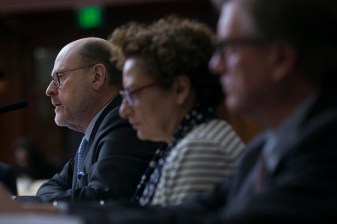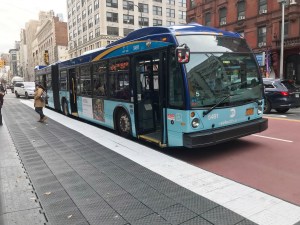NYC Bus Service Isn’t Getting Better, and de Blasio’s Not Doing Much to Fix It
Transportation chair Ydanis Rodriguez and 25 other City Council members called on de Blasio to take up the mantle of "bus mayor" in 2018.

NYC buses are still slowing down and ridership is in free fall, but Mayor de Blasio hasn’t picked up the pace of projects that improve bus service.
So 26 City Council members are calling on de Blasio, who’s in charge of the city’s streets, to use every tool at his disposal to get bus riders moving again.
In a letter sent January 26, transportation chair Ydanis Rodriguez and 25 other council members urged de Blasio to add bus lanes on 10 high-priority routes this year, accelerate the implementation of transit signal priority, and install real-time arrival displays at the city’s 1,000 busiest bus stops by 2020.
“In the next four years, we should be able to modernize our buses,” Rodriguez said at a press conference outside City Hall this afternoon.
Bus ridership dropped six percent in 2017 alone, the greatest single-year decline in 15 years, as average bus speeds got even worse, falling to 7 mph.
Last week, the Bus Turnaround Coalition gave failing grades to nearly three-quarters of all bus routes in the city, based on bus speeds, the share of buses arriving in bunches, and on-time performance.
The 10 routes where advocates want to see bus lanes ASAP are the B41; the B35 on Church Avenue; the Bx19; the Bx28 and Bx38 on Gun Hill Road; the Bx9; the M57 and M31 on 57th Street; the M101 on Third Avenue; the Q58; the Q66, Q68, and Q100 on 21st Street in Astoria and Long Island City; and the S48 on Staten Island’s Victory Boulevard. The routes were chosen based on exceptionally large differences between peak and off-peak bus speeds, which imply that the buses would benefit from bypassing traffic congestion.
The letter also called for improved bus lane enforcement, which Rodriguez said today should come in the form of cameras mounted on the buses themselves. The council members also urged the passage of Intro 163, Mark Levine’s bill requiring the city to install transit signal priority on 60 routes by 2020.
In October, de Blasio announced plans to add 21 new Select Bus Service routes over the next decade, which isn’t any faster than the city’s current pace. DOT’s schedule for transit signal priority implementation is similarly sluggish.
Riders Alliance organizer Stephanie Burgos-Veras said that while advocates welcomed the mayor’s “Bus Forward” initiative, improvements should not be limited to a handful of express routes, as the city calls for. “Our goals here are to improve local bus service,” she said. “He’s taking a few steps, but we believe he could be a little bit more aggressive in turning our system around.”
“This crisis will not be remedied by two or three routes being upgraded per year,” said TransitCenter Deputy Executive Director Tabitha Decker. “We need an ambitious, ongoing program to turn around our local buses right now.”


